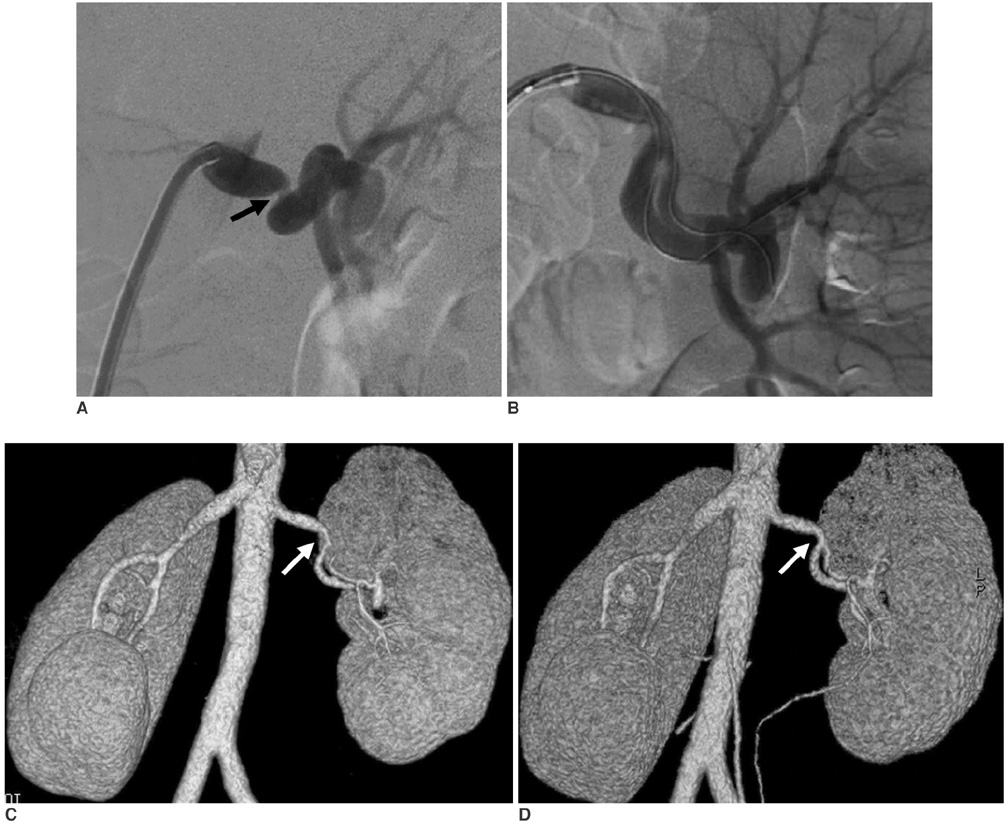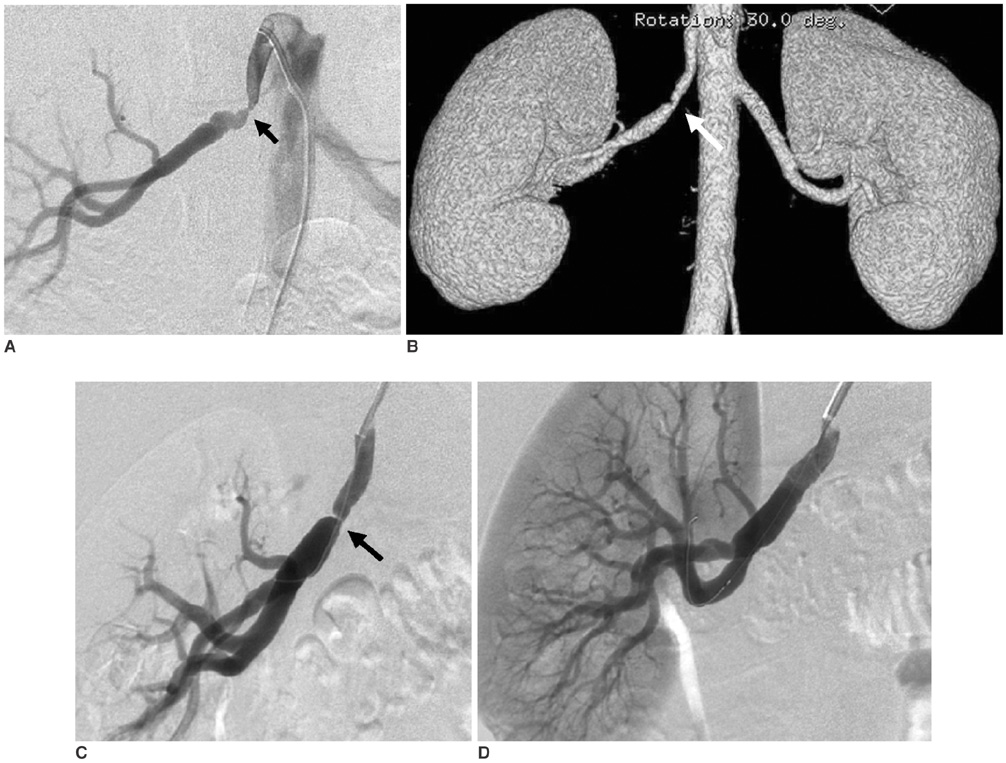Korean J Radiol.
2008 Feb;9(1):38-44. 10.3348/kjr.2008.9.1.38.
Percutaneous Transluminal Angioplasty of Renal Artery Fibromuscular Dysplasia: Mid-term Results
- Affiliations
-
- 1Department of Radiology and Center for Imaging Science, Samsung Medical Center, Sungkyunkwan University School of Medicine, Seoul, Korea. ysdo@smc.samsung.co.kr
- 2Department of Cardiology, Samsung Medical Center, Sungkyunkwan University School of Medicine, Seoul, Korea.
- KMID: 1734273
- DOI: http://doi.org/10.3348/kjr.2008.9.1.38
Abstract
OBJECTIVE
To evaluate mid-term imaging, clinical follow-up, and restenosis rates from patients that had undergone percutaneous transluminal renal artery angioplasty (PTRA) for symptomatic renal artery fibromuscular dysplasia (FMD). MATERIALS AND METHODS: Between March 1999 and July 2006, 16 consecutive renal artery FMD patients underwent PTRA for poorly controlled hypertension. The patients were enrolled into this retrospective study after receiving 19 primary and four secondary PTRAs in 19 renal artery segments. Follow-up monitoring of blood pressure, use of antihypertensive medication, and the serum creatinine level after PTRA were assessed at 1, 3, 6, 9, 12 months, and each following year. The degree of restenosis was evaluated with computed tomographic angiography (CTA) after PTRA at 6, 12 months, and every year if possible. Technical and clinical success rates for the treatment of FMD, and restenosis rates for the renal artery were evaluated. RESULTS: The technical success rate for primary PTRA was 79% (15/19) and the complication rate was 16% (3/19). Hypertension improved in 80% (12/15) of the patients after four weeks follow-up, and was finally cured or improved in 93% (14/15) during the mean follow-up period of 23.6 months. There was a cumulative 22% (4/18) restenosis rate during the follow-up period. All of the patients were treated with a second PTRA without complications and all of the patients were cured of hypertension after the second PTRA. CONCLUSION: Percutaneous transluminal renal artery angioplasty for clinically symptomatic renal FMD is technically and clinically successful and safe to perform. For all patients with restenosis, there was a good response after undergoing a second PTRA.
Keyword
MeSH Terms
Figure
Cited by 1 articles
-
Regions of the human renal artery: histomorphometric analysis
Blanca Mompeó-Corredera, Pablo Hernández-Morera, Irene Castaño-González, María del Pino Quintana-Montesdeoca, Natalia Mederos-Real
Anat Cell Biol. 2022;55(3):330-340. doi: 10.5115/acb.22.072.
Reference
-
1. Safian RD, Textor SC. Renal-artery stenosis. N Engl J Med. 2001. 344:431–442.2. Ekelund L, Gerlock J, Molin J, Smith C. Roentgenologic appearance of fibromuscular dysplasia. Acta Radiol Diagn (Stockh). 1978. 19:433–446.3. Alhadad A, Mattiasson I, Ivancev K, Gottsater A, Lindblad B. Revascularisation of renal artery stenosis caused by fibromuscular dysplasia: effects on blood pressure during 7-year follow-up are influenced by duration of hypertension and branch artery stenosis. J Hum Hypertens. 2005. 19:761–767.4. Dieter RS, Schmidt WS, Pacanowski JP Jr, Jaff MR. Renovascular hypertension. Expert Rev Cardiovasc Ther. 2005. 3:413–422.5. Fenves AZ, Ram CV. Fibromuscular dysplasia of the renal arteries. Curr Hypertens Rep. 1999. 1:546–549.6. Anderson CA, Hansen KJ, Benjamin ME, Keith DR, Craven TE, Dean RH. Renal artery fibromuscular dysplasia: results of current surgical therapy. J Vasc Surg. 1995. 22:207–215. discussion 215-216.7. Beebe HG, Chesebro K, Merchant F, Bush W. Results of renal artery balloon angioplasty limit its indications. J Vasc Surg. 1988. 8:300–306.8. Tegtmeyer CJ, Selby JB, Hartwell GD, Ayers C, Tegtmeyer V. Results and complications of angioplasty in fibromuscular disease. Circulation. 1991. 83:I155–I161.9. Giroux MF, Soulez G, Therasse E, Nicolet V, Froment D, Courteau M, et al. Percutaneous revascularization of the renal arteries: predictors of outcome. J Vasc Interv Radiol. 2000. 11:713–720.10. Klow NE, Paulsen D, Vatne K, Rokstad B, Lien B, Fauchald P. Percutaneous transluminal renal artery angioplasty using the coaxial technique. Ten years of experience from 591 procedures in 419 patients. Acta Radiol. 1998. 39:594–603.11. Yutan E, Glickerman DJ, Caps MT, Hatsukami T, Harley JD, Kohler TR, et al. Percutaneous transluminal revascularization for renal artery stenosis: Veterans Affairs Puget Sound Health Care System experience. J Vasc Surg. 2001. 34:685–693.12. Do YS, Yakes WF, Shin SW, Lee BB, Kim DI, Liu WC, et al. Ethanol embolization of arteriovenous malformations: interim results. Radiology. 2005. 235:674–682.13. Surowiec SM, Sivamurthy N, Rhodes JM, Lee DE, Waldman DL, Green RM, et al. Percutaneous therapy for renal artery fibromuscular dysplasia. Ann Vasc Surg. 2003. 17:650–655.14. McCormack LJ, Poutasse EF, Meaney TF, Noto TJ Jr, Dustan HP. A pathologic-arteriographic correlation of renal arterial disease. Am Heart J. 1966. 72:188–198.15. Mounier-Vehier C, Haulon S, Devos P, Lions C, Jaboureck O, Gaxotte V, et al. Renal atrophy outcome after revascularization in fibromuscular dysplasia disease. J Endovasc Ther. 2002. 9:605–613.16. Rundback JH, Sacks D, Kent KC, Cooper C, Jones D, Murphy T, et al. Guidelines for the reporting of renal artery revascularization in clinical trials. American Heart Association. Circulation. 2002. 106:1572–1585.17. Birrer M, Do DD, Mahler F, Triller J, Baumgartner I. Treatment of renal artery fibromuscular dysplasia with balloon angioplasty: a prospective follow-up study. Eur J Vasc Endovasc Surg. 2002. 23:146–152.18. Bonelli FS, McKusick MA, Textor SC, Kos PB, Stanson AW, Johnson CM, et al. Renal artery angioplasty: technical results and clinical outcome in 320 patients. Mayo Clin Proc. 1995. 70:1041–1052.19. Klinge J, Mali WP, Puijlaert CB, Geyskes GG, Becking WB, Feldberg MA. Percutaneous transluminal renal angioplasty: initial and long-term results. Radiology. 1989. 171:501–506.20. Oguzkurt L, Tercan F, Gulcan O, Turkoz R. Rupture of the renal artery after cutting balloon angioplasty in a young woman with fibromuscular dysplasia. Cardiovasc Intervent Radiol. 2005. 28:360–363.
- Full Text Links
- Actions
-
Cited
- CITED
-
- Close
- Share
- Similar articles
-
- Acute Renal Failure Due to Severe Stenosis of Fibromuscular Dysplasia in a Single Kidney
- A Case of Fibromuscular Dysplasia Associated with Hypertensive Encephalopathy
- One Case of Percutaneous Transluminal Angioplasty of Renal Artery Stenosis Caused by Takayasu's Arteritis
- Coexistence of the Renal Fibromuscular Dysplasia and Familial Adenomatous Polyposis
- Percutaneous transluminal coronary angioplasty for ostial stenosis of the left coronary artery





